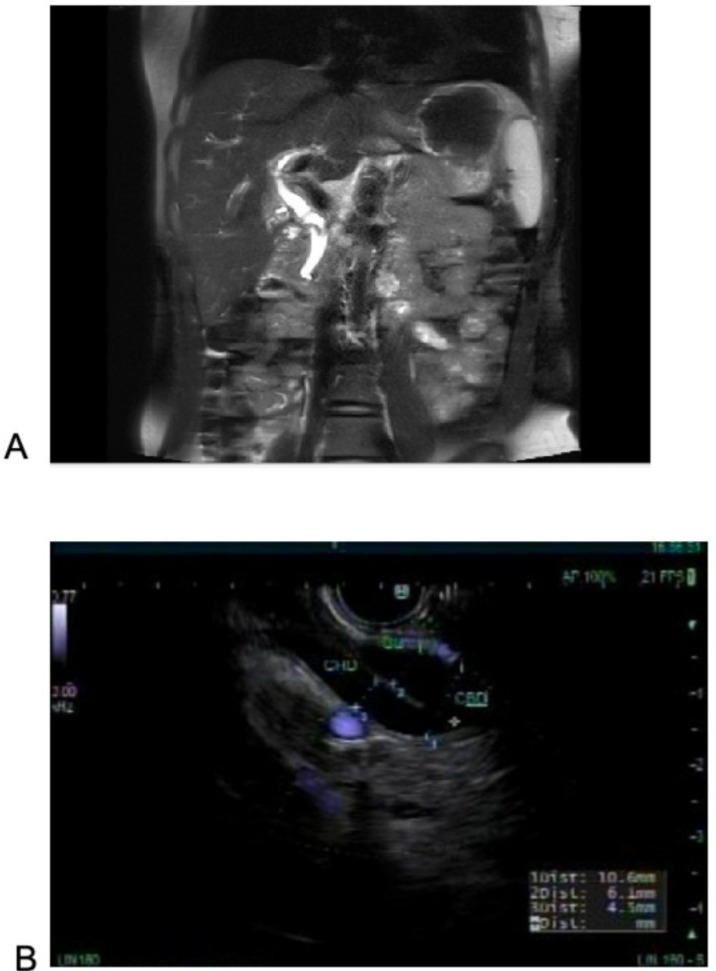Back
Poster Session E - Tuesday Afternoon
E0029 - A Case of Ketamine-Induced Cholangiopathy: A Novel Diagnosis Associated With Chronic Recreational Ketamine Use
Tuesday, October 25, 2022
3:00 PM – 5:00 PM ET
Location: Crown Ballroom

Zhongqian Lin, DO
Maimonides Health
Brooklyn, NY
Presenting Author(s)
Zhongqian Lin, DO1, Larisa Garkusha, MD1, Dmitriy Khodorskiy, MD1, Daria Yunina, MD1, Sadat Iqbal, MD2, Yury Tsirlin, MD1, Maryanne Ruggerio, MD2
1Maimonides Health, Brooklyn, NY; 2Maimonides Medical Center, Brooklyn, NY
Introduction: Ketamine, an analgesic commonly used for procedural sedation, has become a popular agent for recreational use among young adults. The diagnosis of ketamine-induced cholangiopathy is uncommon. We report a case of a young adult with clinical and radiological features consistent with cholangiopathy induced by chronic ketamine use.
Case Description/Methods: A 19-year-old female with past medical history of peptic ulcer disease presented to emergency department (ED) with one year history of severe epigastric abdominal pain. On further questioning, patient reported chronic recreational ketamine use. Physical exam revealed mild epigastric and RUQ tenderness. Liver function test demonstrated elevated alkaline phosphatase of 174 U/L, AST of 237 U/L and ALT of 224 U/L. All other hematology and chemistry results were within normal limits. RUQ ultrasound showed minimally dilated common bile duct (CBD). An MRCP was obtained, showing mild-to-moderate dilatation of intra-/extra-hepatic bile ducts and dilated cystic duct (CD) without obvious intraductal calculi. Endoscopic ultrasonography (EUS) was performed showing dilatation of CBD, minimal dilatation of common hepatic duct, and minimal dilatation of CD, once again without obvious calculi. These imaging findings are compatible with ketamine-induced cholangiopathy. After being admitted for 6 days, the patient demonstrated significant improvement in her abdominal pain, with gradually improving liver test values. She was discharged with the recommendation to abstain from ketamine use and outpatient gastroenterology follow-up.
Discussion: Chronic exposure to ketamine has been known to cause urologic injury, referred to as ketamine-induced ulcerative cystitis. In comparison to the urologic complications of chronic ketamine use, its effects on the biliary system have been less commonly reported. Existing reports have mostly come from regions of Asia where recreational ketamine use is more prevalent. The nonspecific gastrointestinal symptoms that are typically reported by patients with ketamine-induced cholangiopathy may make the diagnosis more challenging to recognize. Due to increasing recreational ketamine use among young adults in recent years, cases of ketamine-induced cholangiopathy are likely to rise. Therefore, a better understanding of the clinical and radiological features of this condition are needed to allow for prompt recognition of ketamine-induced cholangiopathy.

Disclosures:
Zhongqian Lin, DO1, Larisa Garkusha, MD1, Dmitriy Khodorskiy, MD1, Daria Yunina, MD1, Sadat Iqbal, MD2, Yury Tsirlin, MD1, Maryanne Ruggerio, MD2. E0029 - A Case of Ketamine-Induced Cholangiopathy: A Novel Diagnosis Associated With Chronic Recreational Ketamine Use, ACG 2022 Annual Scientific Meeting Abstracts. Charlotte, NC: American College of Gastroenterology.
1Maimonides Health, Brooklyn, NY; 2Maimonides Medical Center, Brooklyn, NY
Introduction: Ketamine, an analgesic commonly used for procedural sedation, has become a popular agent for recreational use among young adults. The diagnosis of ketamine-induced cholangiopathy is uncommon. We report a case of a young adult with clinical and radiological features consistent with cholangiopathy induced by chronic ketamine use.
Case Description/Methods: A 19-year-old female with past medical history of peptic ulcer disease presented to emergency department (ED) with one year history of severe epigastric abdominal pain. On further questioning, patient reported chronic recreational ketamine use. Physical exam revealed mild epigastric and RUQ tenderness. Liver function test demonstrated elevated alkaline phosphatase of 174 U/L, AST of 237 U/L and ALT of 224 U/L. All other hematology and chemistry results were within normal limits. RUQ ultrasound showed minimally dilated common bile duct (CBD). An MRCP was obtained, showing mild-to-moderate dilatation of intra-/extra-hepatic bile ducts and dilated cystic duct (CD) without obvious intraductal calculi. Endoscopic ultrasonography (EUS) was performed showing dilatation of CBD, minimal dilatation of common hepatic duct, and minimal dilatation of CD, once again without obvious calculi. These imaging findings are compatible with ketamine-induced cholangiopathy. After being admitted for 6 days, the patient demonstrated significant improvement in her abdominal pain, with gradually improving liver test values. She was discharged with the recommendation to abstain from ketamine use and outpatient gastroenterology follow-up.
Discussion: Chronic exposure to ketamine has been known to cause urologic injury, referred to as ketamine-induced ulcerative cystitis. In comparison to the urologic complications of chronic ketamine use, its effects on the biliary system have been less commonly reported. Existing reports have mostly come from regions of Asia where recreational ketamine use is more prevalent. The nonspecific gastrointestinal symptoms that are typically reported by patients with ketamine-induced cholangiopathy may make the diagnosis more challenging to recognize. Due to increasing recreational ketamine use among young adults in recent years, cases of ketamine-induced cholangiopathy are likely to rise. Therefore, a better understanding of the clinical and radiological features of this condition are needed to allow for prompt recognition of ketamine-induced cholangiopathy.

Figure: Figure A. MRCP image showing mild-to-moderate dilatation of the intrahepatic and extrahepatic bile ducts and dilatation of the cystic duct. There are no visible stones or evidence of other etiology for the dilatation.
Figure B. EUS image displaying CBD dilatation measuring up to 10.6 mm in the head region, with smooth tapering to the ampulla where it measured 2.7 mm.
Figure B. EUS image displaying CBD dilatation measuring up to 10.6 mm in the head region, with smooth tapering to the ampulla where it measured 2.7 mm.
Disclosures:
Zhongqian Lin indicated no relevant financial relationships.
Larisa Garkusha indicated no relevant financial relationships.
Dmitriy Khodorskiy indicated no relevant financial relationships.
Daria Yunina indicated no relevant financial relationships.
Sadat Iqbal indicated no relevant financial relationships.
Yury Tsirlin indicated no relevant financial relationships.
Maryanne Ruggerio indicated no relevant financial relationships.
Zhongqian Lin, DO1, Larisa Garkusha, MD1, Dmitriy Khodorskiy, MD1, Daria Yunina, MD1, Sadat Iqbal, MD2, Yury Tsirlin, MD1, Maryanne Ruggerio, MD2. E0029 - A Case of Ketamine-Induced Cholangiopathy: A Novel Diagnosis Associated With Chronic Recreational Ketamine Use, ACG 2022 Annual Scientific Meeting Abstracts. Charlotte, NC: American College of Gastroenterology.
